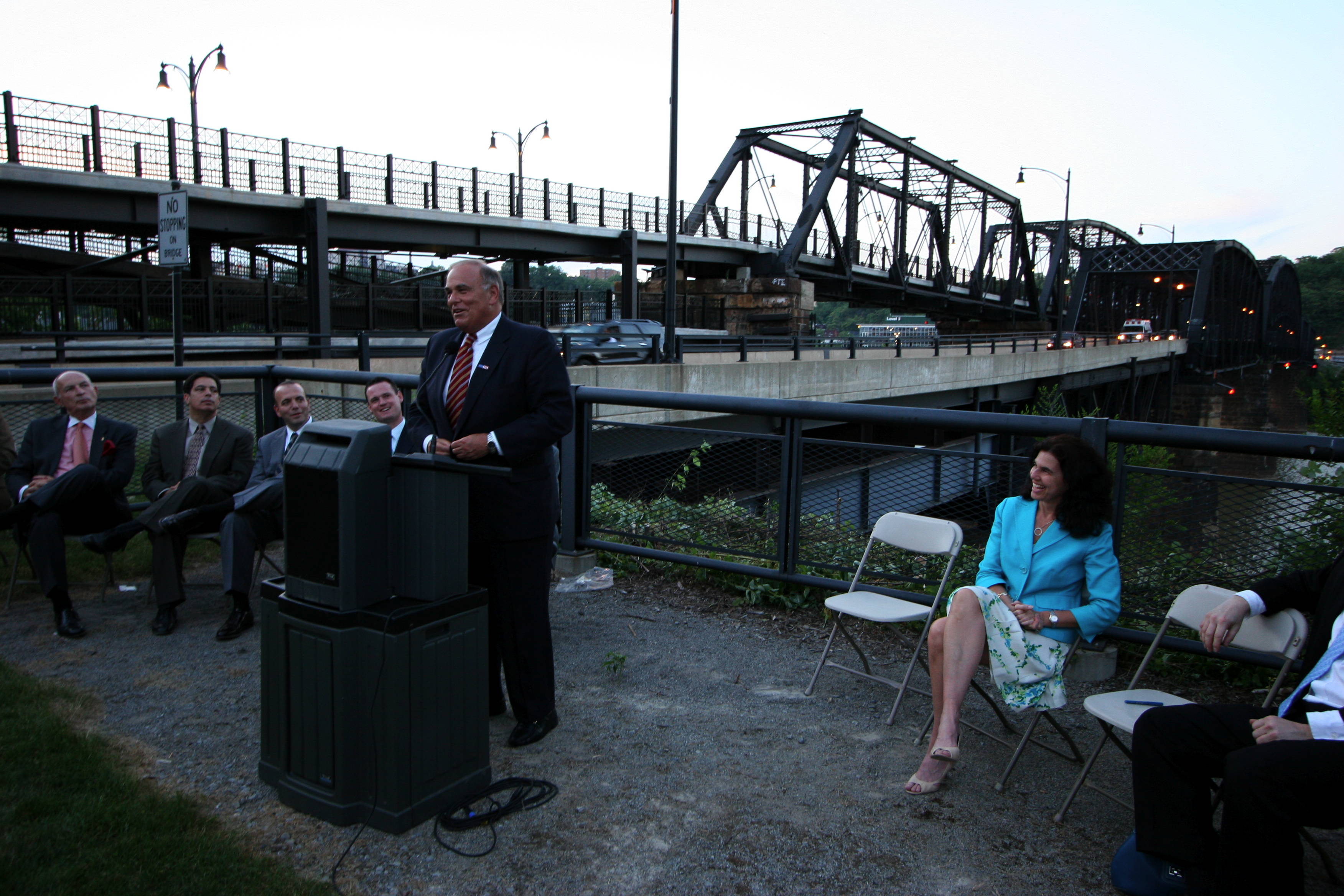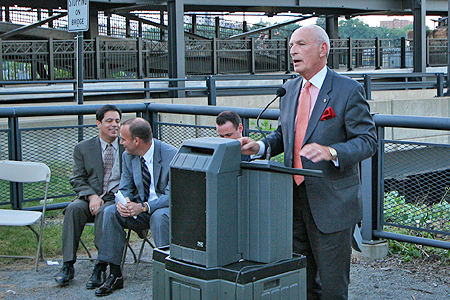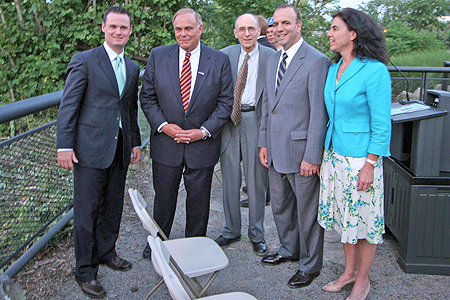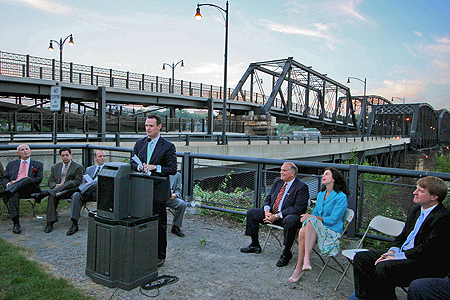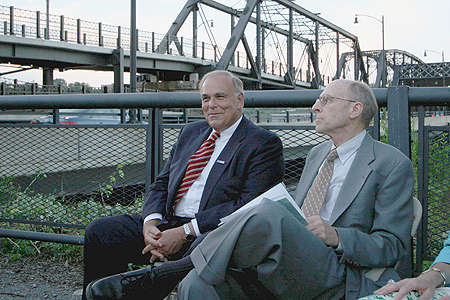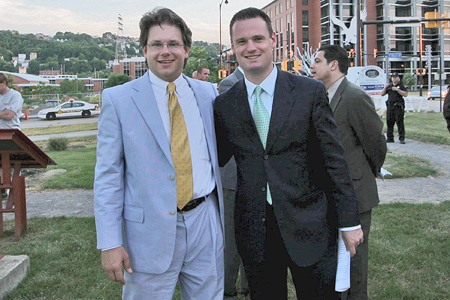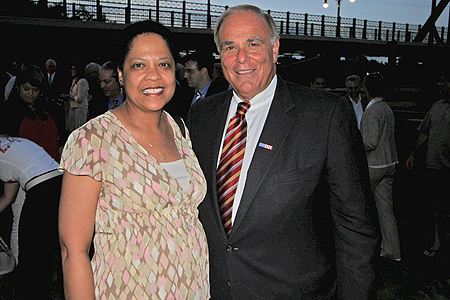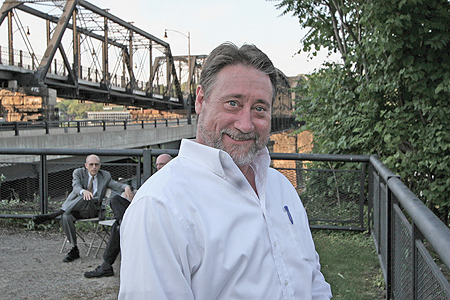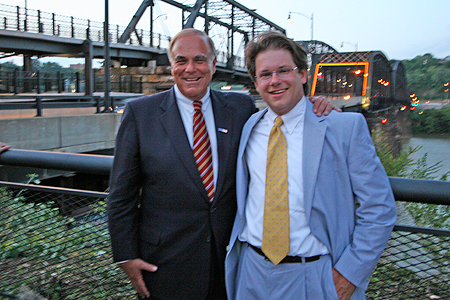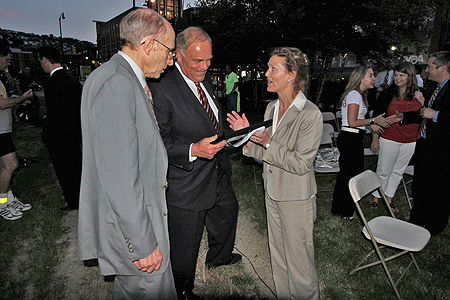
Category Archive: Legislative / Advocacy
-
Hot Metal Bridge Lighted
PHLF News
June 13, 2008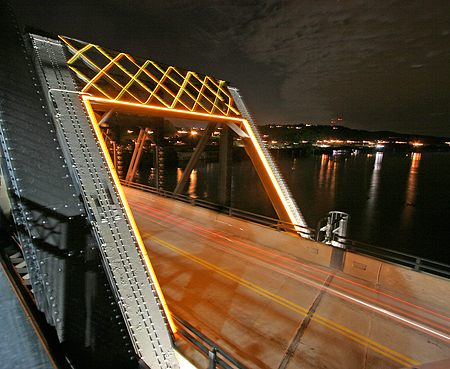
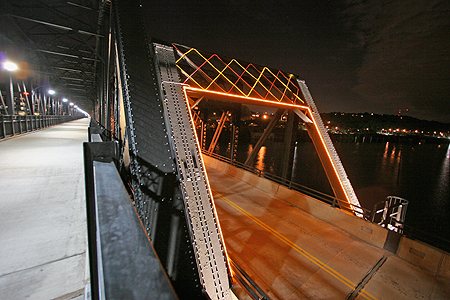
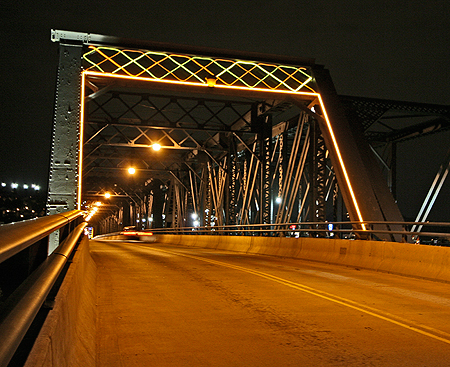
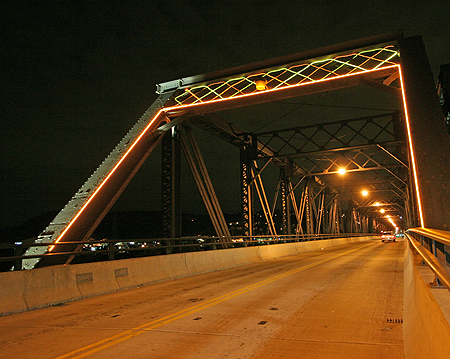
Governor Edward G. Rendell, accompanied by Mayor Luke Ravenstahl, activated the lighting of the portals of the Hot Metal Bridge, as it is commonly called today, at 8:15 p.m., Thursday, June 12, 2008.
The ceremony took place at the Steelworkers’ Monument on the South Bank of the Monongahela River. This was the third bridge decoratively lighted under the auspices of Pittsburgh History & Landmarks Foundation (Landmarks). The first was the Smithfield Street Bridge and the second was the Roberto Clemente Bridge.
Actually, the portal lighting decorates the Main Bridge (Monongahela Connecting Railroad Bridge), constructed in 1904 and opened to motor vehicles in 2000. The Hot Metal Bridge of 1900 (opened to bicycles and pedestrians in 2007) replaced the original Hot Metal Bridge of 1887. With the opening of Hot Metal Street in South Side Works, the name “Hot Metal Bridge” is now commonly used to refer to the historic bridge pair that is built on a shared set of piers.
Historically, hot metal––iron just smelted in a blast furnace and still close to 3,000 degrees Fahrenheit—was transported in ladle cars from the blast furnaces on the north shore of Jones & Laughlin’s Pittsburgh Works across the Hot Metal Bridge of 1900 to the Bessemer converters and open-hearth furnaces of the South Side Plant. The Main Bridge of 1904 served the general purposes of the Monongahela Connecting Railroad, including the transportation of steel ingots and slabs.
The bridge lighting is LED tubular lighting in orange, red, and yellow, suggesting the colors of the hot metal and steel slabs that were once transported across the bridges.
Grenald Waldron Associates of Philadelphia designed the lighting for the bridge as they did for the Roberto Clemente Bridge. Courtney Sarge was the principal designer.
The Governor said, “Grenald has done excellent work once again, we are delighted to see Landmarks utilizing Pennsylvania designers and Pittsburgh contractors for the work that they do with bridge lighting.”
Funding for the project came primarily from a grant from the Department of Community and Economic Development at the Governor’s request. That grant totaled $125,000. Design of the lighting was financed by grants from the Soffer Corporation, the International Brotherhood of Electrical Workers, Wellington Power, and Landmarks totaling $12,500. Landmarks also underwrote an additional $15,000 of costs for the project, bringing the total to approximately $150,000.
Mayor Ravenstahl pointed out, “This is another fine public-private accomplishment in our goal to make Pittsburgh a uniquely attractive city by capitalizing on our historic assets. We thank the Governor and Landmarks and our city team for bringing about this excellent result.
Mark Bibro, Chair of Landmarks, said, “We are grateful that we have a governor who understands the significance of lighting these great engineering monuments to promote their continued use and increase tourism. We are the ‘City of Bridges,’ with 446 bridges (based on the most recent count) within the City limits, and hundreds more throughout Allegheny County. We must continue this lighting program.
Founded in 1964, the Pittsburgh History & Landmarks Foundation works to identify and save architectural landmarks; revitalize historic neighborhoods; and instill community pride. Visit www.phlf.org or call 412-471-5808 for information about preservation services, educational programs, and membership benefits.
# # #
-
PHLF Main Street Program Expands
By Ethan Raup
Manager, Community Revitalization ProgramsThe PHLF Main Street revitalization program expanded this spring into Armstrong County with a partnership with the Freeport, Leechburg and Apollo Group (FLAG) and with funding obtained by Sen. Jim Ferlo. PHLF is working with FLAG to submit their state main street application in August. If accepted, FLAG would be the first regional main street program in western Pennsylvania.
Freeport, Leechburg and Apollo are small towns with traditional main street business districts that are within 10 miles of each other along the Kiskimenitas and Allegheny Rivers. Alone, each town is too small to qualify as a state main street. So leaders in these towns decided to join together to pursue the state’s regional main street designation.
PHLF’s work includes staffing FLAG’s Board and its four committees – Promotions, Design, Organization and Economic Restructuring. We are developing an aggressive five year work plan that builds on local assets and addresses challenges head-on. We are also taking early implementation steps wherever possible. That includes a study to explore restoring and returning the former Leechburg Hotel building to its original use.
With direct access to the Kiski River, a picturesque surrounding countryside, abundant trail connections and traditional towns that are still largely intact, the FLAG communities have a real opportunity to develop into a regional destination. The Leechburg Hotel could be key to this effort. And it dovetails nicely with PHLF’s work on the historic main street in Vandergrift, which is just across the Kiski river in Westmoreland County.
The FLAG effort began two years ago with the help of Sen. Ferlo, who has been a strong advocate for FLAG and this revitalization effort. We are optimistic that FLAG will receive its Main Street designation later this year. PHLF anticipates working hand in hand with FLAG in 2009 and beyond to help breathe new life into each town.
With the FLAG communities, PHLF is now active in 8 main street revitalization efforts across southwestern Pennsylvania, including Stowe, Swissvale, Tarentum, Elizabeth and Vandergrift. In each of these towns, PHLF is drawing upon our depth of experience and expertise to find a path forward that we believe will lead to a sustained revitalization.
-
Easement Policy Revised
Landmarks recently revised its Easement Policy in accordance with the Land Trust Alliance’s Standards and Practices, as recommended by the National Trust for Historic Preservation. The Standards and Practices are “ethical and technical guidelines for the responsible operation of a land trust.”
Landmarks holds easements on a variety of historic properties throughout western Pennsylvania including single family homes in the Mexican War Streets, historic farms in Greene and Washington County, the Heinz Lofts, Armstrong Cork and the recently restored Bedford Springs Resort to name a few.
Preservation easements are recorded land use agreements in which a property owner voluntarily places restrictions on the building and/or land that maintain the historic or architectural significance of the property. Preservation easements, therefore, are an important historic preservation tool because they preserve historic buildings in perpetuity. Donors of preservation easements may also qualify for a federal charitable contribution deduction.
-
Streetscape funding awaits Bush’s signature
Thursday, May 08, 2008The federal transportation bill that includes streetscape funding for Heidelberg, Scott and Carnegie is headed to the White House for approval.
H.R. Bill 1195, which as of last Thursday had passed both houses of Congress, contains $2.4 million that will be targeted for various street improvements between First and Third streets on Route 50 in Heidelberg, Carothers Avenue in Scott and Third Street in Carnegie.
“Being a center point between the airport and the city, and at the crossroads of two interstate highways, these communities have so much to offer,” said U. S. Rep. Tim Murphy, R-Upper St. Clair, who developed the revitalization initiative.
Specifics of the streetscape plan need to be worked out, but past discussions have included using the federal money to repair infrastructure, relocate utility lines, provide secure lighting and add other amenities such as decorative benches and planters to make the three communities more inviting.
In addition, the Port Authority and the Pittsburgh History and Landmarks Foundation are working with the communities to introduce transit-oriented development and create a blueprint for revitalization.
Legislation containing the funding passed the U.S. House twice, most recently in March 2007, but was held up in the Senate.
Mr. Murphy, who secured money in the House version, worked with U.S. Sen. Arlen Specter, R-Pennsylvania, to move the bill in the Senate with additional funding for the project.
“This is an exciting springboard for these areas that have tried to rebuild,” Mr. Murphy said. “As the plans are developed, community input will be essential.”
He estimated that it would be several months after President Bush signs the bill before the money would be available.
Mr. Murphy added that the U.S. Army Corps of Engineers is in the midst of a $4.5 million plan to remove sediment from areas prone to flooding, such as Chartiers Creek and Robinson Run.
Carole Gilbert Brown is a freelance writer.First published on May 8, 2008 at 5:39 am -
National Negro Opera House Hearing at Pittsburgh Council
PREPARED TESTIMONY OF
ANNE E. NELSON, ESQ.
GENERAL COUNSEL
PITTSBURGH HISTORY & LANDMARKS FOUNDATION
BEFORE THE PITTSBURGH CITY COUNCIL
PUBLIC HEARING ON THE NATIONAL NEGRO OPERA HOUSE
CITY HISTORIC STRUCTURE DESIGNATION
MAY 7, 2008
Pittsburgh History & Landmarks Foundation (Landmarks) supports the nomination of 7101 Apple Street, the National Negro Opera House, to be a City-Designated Historic Structure. Built in 1894, this Queen Anne-style house received a historical marker from the Commonwealth of Pennsylvania in 1994, and is included in African American Historic Sites Survey of Allegheny County, published by the Pennsylvania Historical and Museum Commission in 1994, and A Legacy in Bricks and Mortar: African-American Landmarks in Allegheny County, published by Landmarks in 1995.
Therefore, Landmarks supports the designation of this site as a City of Pittsburgh Historic Structure.
-
Survey of Greene and Washington Counties
Eugene Matta
PHLF News
March 7, 2008The Farm Survey of Greene and Washington Counties, managed by PHLF under the auspices of the Pennsylvania Bureau of Historic Preservation (“BHP”), is about ninety percent complete.
The survey contains a list of 1,150 farms and farmsteads from both counties and includes photographs and descriptions of historic buildings, uses of farm lands, and potential priorities for easements.
The survey focuses primarily on existing historic structures. For the next steps, Landmarks hopes to work with local organizations from both counties to help promote agricultural tourism.
The survey information will also be compiled in a statewide database managed by the BHP.
-
Public Hearing Before the Planning Commission of the City of Pittsburgh on the Workingman’s Savings Bank City Historic Structure Nomination
PREPARED TESTIMONY OF
ANNE E. NELSON, ESQ.
GENERAL COUNSEL
PITTSBURGH HISTORY & LANDMARKS FOUNDATION
BEFORE THE PLANNING COMMISSION, CITY OF PITTSBURGH
ON THE WORKINGMAN’S SAVINGS BANK
CITY HISTORIC STRUCTURE NOMINATION
FEBRUARY 26, 2008
Pittsburgh History & Landmarks Foundation urges the Planning Commission to recommend to the City Council the designation of the Workingman’s Savings Bank as a City Historic Structure.
The Workingman’s Savings Bank is the anchor building on the west corner of E. Ohio Street; the historic Teutonia Mannerchor serves as the east anchor. Removing an anchor building, one of the original elements remaining on that side of East Deutschtown, will have a detrimental impact on the neighborhood. Designating the property to City Historic Structure status will not only ensure its preservation, it will encourage the future development of the area to be consistent with the size, scale, design and character of the surrounding neighborhood. This designation will have a positive impact on the adjacent properties and the surrounding neighborhood by promoting the proper redevelopment of the area.
Furthermore, the incorporation of the building into a larger development is a viable option that may benefit the owner through the use of federal historic preservation tax incentives. The Workingman’s Savings Bank was determined eligible for listing on the National Register of Historic Places on February 24, 1986. Buildings listed on or eligible for the National Register may qualify for a 20% historic rehabilitation tax credit. A property owner may also donate a preservation easement to a qualified organization to receive a charitable contribution deduction. The combination of these two historic preservation tax incentives has successfully been used on developments in Pittsburgh including the Heinz Lofts and the Armstrong Cork Factory. Our organization would be interested in receiving one. If not eligible for the National Register, a 10% tax credit is also available for substantial rehabilitation costs since the building was constructed prior to 1936.
Finally, I would like to present a letter dated February 11, 2008 from Christopher Ponticello, Legal Counsel for the Diocese of Pittsburgh, that states the Diocese has received no payment from the successful purchaser of the building in exchange for the Diocese to relinquish its rights to the property. The Diocese’s attorney should be contacted for more information.
Pittsburgh History & Landmarks Foundation supports the nomination of the Workingman’s Savings Bank to a City Historic Structure.
-
Decision on Schenley High School postponed
Wednesday, January 30, 2008
By Joe Smydo,
Pittsburgh Post-GazetteThe city school board’s vote on the closing of the Pittsburgh Schenley High School building will be put off until spring so officials can continue to study the feasibility of renovating the building.
A vote on the building’s fate was widely expected at the board’s Feb. 27 legislative meeting.
Pittsburgh Public Schools Superintendent Mark Roosevelt last night said he didn’t want to give Schenley supporters false hope, but wants more time to study “every option” for saving the building.
“We believe we should spend a couple of extra months doing that,” he told board members at a workshop on high school improvement.
School board member Heather Arnet thanked Mr. Roosevelt for considering pleas to spare the historic Oakland building.
Kathy Fine, a Schenley supporter, called the announcement a “very positive move” and a nod to community members who have been brainstorming for ways to raise money and reduce renovation costs.
Mr. Roosevelt unleashed a firestorm last fall when he proposed closing the building at the end of the school year, saying the district couldn’t afford $64 million to address asbestos and other maintenance problems.
He has proposed moving Schenley’s current 10th-, 11th- and 12th-graders to the Reizenstein building in Shadyside next school year and allowing them to remain together until graduation. Students who would have entered Schenley as freshmen next school year would be absorbed by other schools.
The district held a public hearing on the proposal Nov. 27 so the board could vote Feb. 27. State law requires that a hearing be held at least three months before the vote to close a school.
Mr. Roosevelt said he never committed to a Feb. 27 vote on the building’s future, though people have had that impression. He said he will ask the board to vote next month on moving students out of the Schenley building for the next school year.
Whether the building is closed or renovated, he said, students won’t be able to attend class there in 2008-09.
He said the board must vote promptly on reassigning the students so Reizenstein or another building can be readied for them.
Joe Smydo can be reached at jsmydo@post-gazette.com or 412-263-1548.
First published on January 30, 2008 at 12:00 am


